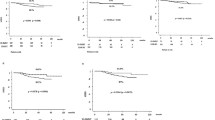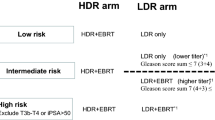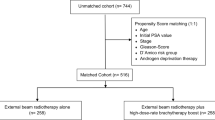Abstract
Background
Although brachytherapy is a standard treatment option for patients with high-risk prostate cancer, only a few studies have compared low-dose-rate brachytherapy (LDR-BT) and high-dose-rate brachytherapy (HDR-BT). We applied propensity score-based inverse probability treatment weighting (IPTW) to compare oncological outcomes for LDR-BT and HDR-BT.
Methods
We retrospectively assessed prognosis in 392 patients with high-risk localized prostate cancer who had undergone brachytherapy plus external beam radiation. IPTW was applied to adjust the Kaplan–Meier survival analyses and Cox proportional hazards regression analyses, with the goal of minimizing bias from patient background.
Results
The IPTW-adjusted Kaplan–Meier survival analyses showed no statistically significant differences for time to biochemical recurrence, clinical progression, castration-resistant prostate cancer, or death from any cause. The IPTW-adjusted Cox regression analyses also showed that the modality of brachytherapy was not an independent factor in these oncological outcomes. Notably, the two groups differed regarding complications; LDR-BT was associated with a higher rate of acute grade ≥ 2 GU toxicity, and late grade 3 toxicity was noted only in HDR-BT.
Conclusion
Our analysis of long-term outcomes in patients with high-risk localized prostate cancer shows no significant differences in oncological outcomes between LDR-BT and HDR-BT, but some differences in toxicity, and offers patients and clinicians useful information in deciding management strategies for high-risk localized prostate cancer.



Similar content being viewed by others
Data availability
The datasets used and/or analyzed during the current study are available from the corresponding author on reasonable request.
Change history
09 October 2023
A Correction to this paper has been published: https://doi.org/10.1007/s10147-023-02415-w
References
Cooperberg MR, Cowan J, Broering JM et al (2008) High-risk prostate cancer in the United States, 1990–2007. World J Urol 26(3):211–218
Moris L, Cumberbatch MG, Van den Broeck T et al (2020) Benefits and risks of primary treatments for high-risk localized and locally advanced prostate cancer: an international multidisciplinary systematic review. Eur Urol 77(5):614–627
Morris WJ, Tyldesley S, Rodda S et al (2017) Androgen suppression combined with elective nodal and dose escalated radiation therapy (the ASCENDE-RT Trial): an analysis of survival endpoints for a randomized trial comparing a low-dose-rate brachytherapy boost to a dose-escalated external beam boost for high- and intermediate-risk prostate cancer. Int J Radiat Oncol Biol Phys 98(2):275–285
Johnson SB, Lester-Coll NH, Kelly JR et al (2017) Brachytherapy boost utilization and survival in unfavorable-risk prostate cancer. Eur Urol 72(5):738–744
Vigneault E, Mbodji K, Magnan S et al (2017) High-dose-rate brachytherapy boost for prostate cancer treatment: different combinations of hypofractionated regimens and clinical outcomes. Radiother Oncol 124(1):49–55
Kent AR, Matheson B, Millar JL (2019) Improved survival for patients with prostate cancer receiving high-dose-rate brachytherapy boost to EBRT compared with EBRT alone. Brachytherapy 18(3):313–321
National Comprehensive Cancer Network Prostate cancer (version 1. https://www.nccn.org/professionals/physician_gls/pdf/prostate.pdf). Accessed 1 July 2023
Edge SB, Byrd DR, Compton CC et al (2009) American joint committee on cancer staging manual, 7th edn. Springer, New York
Urabe F, Miki K, Kimura T et al (2022) Long-term outcomes of radical prostatectomy versus low-dose-rate brachytherapy in patients with intermediate-risk prostate cancer: propensity score matched comparison. Prostate 81:S1401
Urabe F, Miki K, Kimura T et al (2022) Clinical significance of unfavorable findings in intermediate-risk prostate cancer patients for predicting treatment outcomes after contemporary, dose-escalated multimodal radiotherapy. Prostate 82(4):433–441
Urabe F, Kimura T, Sasaki H et al (2022) How long is long enough to secure disease control after low-dose-rate brachytherapy in combination with other modalities in intermediate-risk, localized prostate cancer? Int J Clin Oncol 27(1):184–193
Konaka H, Egawa S, Saito S et al (2012) Tri-Modality therapy with I-125 brachytherapy, external beam radiation therapy, and short- or long-term hormone therapy for high-risk localized prostate cancer (TRIP): study protocol for a phase III, multicenter, randomized, controlled trial. BMC Cancer 12:110
Mori K, Sasaki H, Tsutsumi Y et al (2021) Trimodal therapy with high-dose-rate brachytherapy and hypofractionated external beam radiation combined with long-term androgen deprivation for unfavorable-risk prostate cancer. Strahlenther Onkol 197(11):976–985
Roach M 3rd, Hanks G, Thames H Jr et al (2006) Defining biochemical failure following radiotherapy with or without hormonal therapy in men with clinically localized prostate cancer: recommendations of the RTOG-ASTRO Phoenix Consensus Conference. Int J Radiat Oncol Biol Phys 65(4):965–974
Scher HI, Morris MJ, Stadler WM et al (2016) Trial design and objectives for castration-resistant prostate cancer: updated recommendations from the prostate cancer clinical trials working group 3. J Clin Oncol 34(12):1402–1418
Kishan AU, Cook RR, Ciezki JP et al (2018) Radical prostatectomy, external beam radiotherapy, or external beam radiotherapy with brachytherapy boost and disease progression and mortality in patients with Gleason score 9–10 prostate cancer. JAMA 319(9):896–905
King MT, Yang DD, Muralidhar V et al (2019) A comparative analysis of overall survival between high-dose-rate and low-dose-rate brachytherapy boosts for unfavorable-risk prostate cancer. Brachytherapy 18(2):186–191
Yamazaki H, Masui K, Suzuki G et al (2021) High-dose-rate brachytherapy with external beam radiotherapy versus low-dose-rate brachytherapy with or without external beam radiotherapy for clinically localized prostate cancer. Sci Rep 11(1):6165
Miki K, Kiba T, Sasaki H et al (2010) Transperineal prostate brachytherapy, using I-125 seed with or without adjuvant androgen deprivation, in patients with intermediate-risk prostate cancer: study protocol for a phase III, multicenter, randomized, controlled trial. BMC Cancer 10:572
Grills IS, Martinez AA, Hollander M et al (2004) High dose rate brachytherapy as prostate cancer monotherapy reduces toxicity compared to low dose rate palladium seeds. J Urol 171(3):1098–1104
Hathout L, Mahmoud O, Wang Y et al (2019) A phase 2 randomized pilot study comparing high-dose-rate brachytherapy and low-dose-rate brachytherapy as monotherapy in localized prostate cancer. Adv Radiat Oncol 4(4):631–640
Reynaud T, Hathout L, Carignan D et al (2021) PSA outcomes and late toxicity of single-fraction HDR brachytherapy and LDR brachytherapy as monotherapy in localized prostate cancer: a phase 2 randomized pilot study. Brachytherapy 20(6):1090–1098
Major T, Polgár C, Jorgo K et al (2017) Dosimetric comparison between treatment plans of patients treated with low-dose-rate vs. high-dose-rate interstitial prostate brachytherapy as monotherapy: initial findings of a randomized clinical trial. Brachytherapy 16(3):608–615
Tward JD, Jarosek S, Chu H et al (2016) Time course and accumulated risk of severe urinary adverse events after high- versus low-dose-rate prostate brachytherapy with or without external beam radiation therapy. Int J Radiat Oncol Biol Phys 95(5):1443–1453
Hindson BR, Millar JL, Matheson B (2013) Urethral strictures following high-dose-rate brachytherapy for prostate cancer: analysis of risk factors. Brachytherapy 12(1):50–55
King CR (2002) LDR vs. HDR brachytherapy for localized prostate cancer: the view from radiobiological models. Brachytherapy 1(4):219–226
Brenner DJ, Hall EJ (1999) Fractionation and protraction for radiotherapy of prostate carcinoma. Int J Radiat Oncol Biol Phys 43(5):1095–1101
Brenner DJ, Martinez AA, Edmundson GK et al (2002) Direct evidence that prostate tumors show high sensitivity to fractionation (low alpha/beta ratio), similar to late-responding normal tissue. Int J Radiat Oncol Biol Phys 52(1):6–13
Acknowledgements
This study was supported in part by a Grant, SHIP0804 NCT00664456. We thank Dr. Takaya Sasaki, Department of Nephrology and Hypertension, The Jikei University School of Medicine for critical discussion and revision of this manuscript. English-language editorial support was provided by Lee Seaman of Seaman Medical, Inc., Bellingham WA USA.
Author information
Authors and Affiliations
Corresponding author
Ethics declarations
Conflict of interest
No author has any conflict of interest.
Additional information
Publisher's Note
Springer Nature remains neutral with regard to jurisdictional claims in published maps and institutional affiliations.
Supplementary Information
Below is the link to the electronic supplementary material.
About this article
Cite this article
Imai, Y., Urabe, F., Iwatani, K. et al. Comparison of outcomes in high-risk prostate cancer patients treated with low-/high-dose-rate brachytherapy plus external beam radiotherapy. Int J Clin Oncol 28, 698–706 (2023). https://doi.org/10.1007/s10147-023-02314-0
Received:
Accepted:
Published:
Issue Date:
DOI: https://doi.org/10.1007/s10147-023-02314-0




